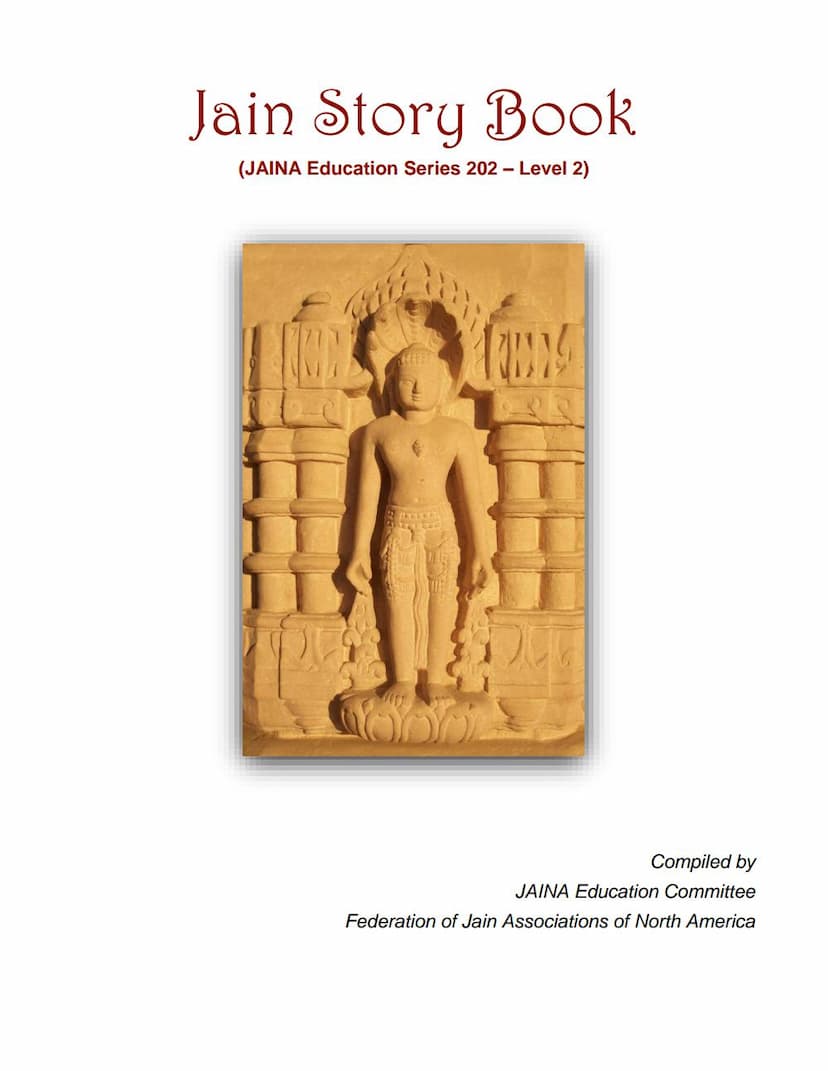JES 202 Jain Story Book Level 2 Book
Added to library: September 1, 2025
Loading image...

Summary
This document is the "Jain Story Book - JES 202 Level 2 Book," compiled by the JAINA Education Committee. It is a religious educational resource designed to teach Jain principles through stories.
Key aspects of the book include:
- Purpose: To make Jain principles widely available in English for Jain youth and laypeople who may not have access to Jain educational material in other languages.
- Target Audience: Primarily aimed at children aged 10-12, as it is part of a series categorized by age levels.
- Content Organization: The book is structured into several parts, covering:
- Part I: Tirthankars: Introductions to the lives of key Tirthankars like Bhagawan Mahävir, Bhagawän Ädinäth, Bhagawan Mallinath, Bhagawan Neminath, and Bhagawan Pärshvanäth. Each Tirthankar's story focuses on their birth, life, renunciation, and attainment of omniscience (Keval-jnän), highlighting their moral teachings.
- Part II: Ganadhars and Acharyas: Stories about the principal disciples (Ganadhars) of Bhagawan Mahävir, such as Gautam-swämi and Sudharmä-swämi, and important Jain scholars (Acharyas) like Sthulibhadra, Kunda-kunda, Haribhadra-Suri, and Hemchandra. These stories often emphasize their intellectual prowess, spiritual dedication, and contributions to Jain literature and philosophy.
- Part III: Stories Preceding Bhagawan Mahävir: Narratives from previous epochs, including the stories of Bharat and Bähubali, King Megharath, Sage Nandisen, King Shripäl and Mayanä-sundari, Ilächikumä, and Monk Kurgadu. These stories often illustrate principles like ego, compassion, tolerance, and the consequences of karma.
- Part IV: Stories during Bhagawan Mahävir: Accounts of events and individuals during Bhagawan Mahävir's lifetime, such as Mahävir-swämi and the Cowherd, Chandkaushik, Chandanbälä, Nails in the Ears: Last Calamity for Bhagawän Mahävir, Meghakumä, Aimuttä Muni, Anand Shrävak, Puniä Shrävak, Shälibhadra, King Shrenik and Queen Chelnä, King Shrenik and Anäthi Muni, King Shrenik's Destiny, Monk Prasannachandra, Abhaykumar and Thief Rohineya. These stories often focus on Mahävir's teachings, non-violence, karma, and self-control.
- Part V: Stories after Bhagawan Mahävir: Stories about influential figures and events in Jain history after Mahävir's passing, including Vajrakumär, King Samprati, Temples of Delwädä (stories of Vimalshä and Vastupäl/Tejpäl), Udayan Mantri and His Sons (Ämbad and Bähad), and the Nobility of Savchand and Somchand. These highlight devotion, architectural contributions, and ethical conduct.
- Part VI: Contemporary Jain Legends: Biographies of significant Jain figures from more recent times, such as Shrimad Räjchandra and Virchand R. Gandhi, showcasing their impact on Jain philosophy, social reform, and spreading Jainism globally.
- Part VII: Moral Stories: Shorter, standalone moral lessons such as King Hansa, Kamalsen, Vipul and Vijan, Two Frogs, and Believe in Yourself. These stories often use allegorical or simple narratives to convey specific virtues like truthfulness, devotion, destiny, perseverance, and the power of words.
- Core Jain Principles Emphasized: The book consistently highlights fundamental Jain principles such as:
- Ahimsa (Non-violence): The paramount importance of not harming any living being.
- Anekäntaväda (Non-absolutism/Manysidedness): The idea that truth is relative and can be viewed from multiple perspectives.
- Aparigraha (Non-possession/Non-attachment): Detachment from material possessions and worldly desires.
- Karma: The law of cause and effect, where actions lead to consequences, shaping one's present and future lives.
- Moksha (Liberation): The ultimate goal of spiritual life, achieved by eradicating all karma.
- Virtues: Emphasizes virtues like truthfulness, forgiveness, compassion, humility, contentment, honesty, and self-restraint.
- Educational Approach: The stories often conclude with a "Moral" and "Questions" section to encourage reflection and understanding of the lessons presented.
- Accessibility: The book states it has "No Copyright" for private, personal, and non-commercial use and encourages respectful use of the religious material for non-profit purposes. It also mentions that soft copies are available for free download from www.jaineLibrary.org.
- Revisions and Acknowledgements: The fifth edition (revised) acknowledges the contributions of various educators, youth, and scholars from around the world. It also notes modifications made to popular versions of some stories to align them with Jain principles and modern cultural values.
- Language and Transliteration: A simplified diacritical mark scheme has been adopted for Jain words to aid pronunciation, though it's noted as not entirely authentic or consistent.
In essence, "Jain Story Book - JES 202 Level 2 Book" serves as an accessible and engaging introduction to Jainism for young readers, using narrative to impart core philosophical tenets and ethical teachings.